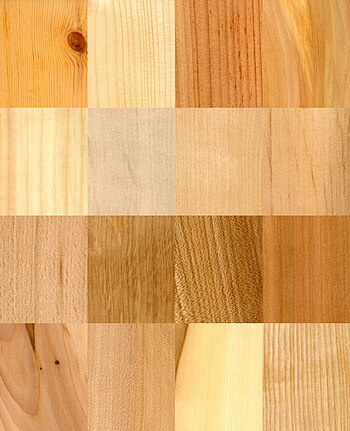hard. fibrous inner part of tree trunks. branches. and stems. The secondary xylem of seed plants.
This article needs additional citations for verification. (February 2021) |
Wood is a structural tissue found in the stems and roots of trees and other woody plants. It is an organic material – a natural composite of cellulose fibers that are strong in tension and embedded in a matrix of lignin that resists compression. Wood is sometimes defined as only the secondary xylem in the stems of trees, or more broadly to include the same type of tissue elsewhere, such as in the roots of trees or shrubs. In a living tree it performs a support function, enabling woody plants to grow large or to stand up by themselves. It also conveys water and nutrients between the leaves, other growing tissues, and the roots. Wood may also refer to other plant materials with comparable properties, and to material engineered from wood, woodchips, or fiber.
Wood samples
|
Wood has been used for thousands of years for fuel, as a construction material, for making tools and weapons, furniture and paper. More recently it emerged as a feedstock for the production of purified cellulose and its derivatives, such as cellophane and cellulose acetate.
As of 2020, the growing stock of forests worldwide was about 557 billion cubic meters. As an abundant, carbon-neutral renewable resource, woody materials have been of intense interest as a source of renewable energy. In 2008, approximately 3.97 billion cubic meters of wood were harvested. Dominant uses were for furniture and building construction.
Wood is scientifically studied and researched through the discipline of wood science, which was initiated since the beginning of the 20th century.

